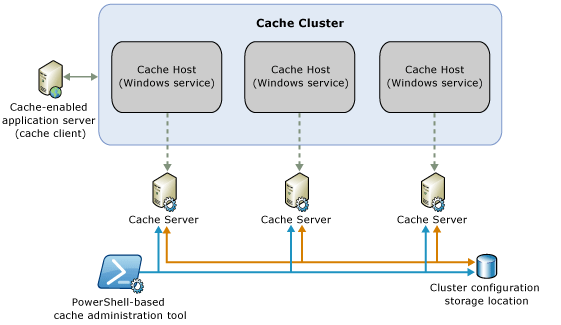Introduction
Microsoft AppFabric for Windows Server Caching features use a cluster of servers that communicate with each other to form a single, unified application cache system. As a distributed cache system, all cache operations are abstracted to a single point of reference, referred to as the cache cluster. In other words, your client applications can work with a single logical unit of cache in the cluster regardless of how many computers make up the cache cluster.
The primary components of the physical architecture consist of the cache server, the cache host Windows service, the cache cluster, the Windows PowerShell-based cache administration tool, the cluster configuration storage location, and the cache client.

Figure 1 : The Microsoft AppFabric Caching architecture
The AppFabric Caching Service is a Windows service that runs on one or more servers. Each server that runs the Caching Service is referred to as a cache server. For each cache server, only one instance of the Caching Service can be installed.
The cache cluster is a collection of one or more instances of the Caching Service working together in the form of a ring to store and distribute data. Data is stored in memory to minimize response times for data requests. The operations of the cache cluster are managed by a role, named the cluster management role. The primary responsibility of the cluster management role includes:
- Keeping the cache cluster running at all times.
- Monitoring the availability of all cache hosts in the cache cluster.
- Helping cache hosts join the cache cluster.
Any application server that is running a cache-enabled application may be loosely referred to as the cache client. For an application to be cache-enabled, it must use the AppFabric Caching assemblies.
Cache is a key ingredient in the design and delivery of a wide variety of applications ranging from single-user embedded systems to large, multi-server, multi-user installations (such as those required by banks, hospitals, etc.) providing essential services to end-users.
This dependence on Cache for performing business-critical tasks and for developing mission-critical applications could only mean that even a wafer-thin deviation in its performance could cause an enterprise to lose millions. Database administrators are thus faced with the daunting task of ensuring the 24x7 availability of the Microsoft AppFabric Caching feature and the optimal performance of all its components. eG Enterprise helps administrators in this task.
